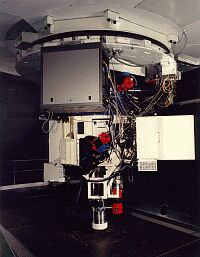The main goals are to provide:
a range of dispersions between 130 and 16 Å/mm in first order, corresponding
to a range in resolving power respectively between 800 and 7000 when using
a narrow (0.5 arc sec) slitwidth; maximum possible throughput; high operating
efficiency in both the setting-up and observing modes, with the capability
of operating the blue and red spectrographs as a single unit; rapid interchange
between ISIS and the Faint Object Spectrograph, which share the same slit
assembly; long slit (4 arc min), multi-slit and fibre optic feed capabilities;
a cross-dispersed mode capable of recording the wavelength range from 3000
to 1100 nm with a resolving power of about 2000; facilities for spectro-polarimetry;
and full capability of being remotely operated.
One of the ISIS capabilities is to convert the spectrograph into a
spectropolarimeter, capable of measuring linear and circular polarization.
The polarimetric capability became available for testing in the spring of 1990,
and as a common-user option (for linear polarization) by the end of that year.
ISIS can also operate with fibres. First commissioning run was in April
1992. Two different bundles are used: a 61-fibre multiobject 400 micron
bundle and a 125-fibre fixed 200 micron array. In either case the output end
of the fibres is arranged in a linear array at the multislit position of ISIS.
Circular spectropolarimetry (using the quarter-wave plate) and imaging
polarimetry with ISIS were first commissioned in 1993.
The ISIS multislit facility was withdrawn in 1993.
A new dichroic filter replaced the former one in 2005.
First use of an L3CCD on ISIS in 2007.
Time allocations:
Nights scheduled since semester 2007B
Instrument information: http://www.ing.iac.es/astronomy/instruments/isis/index.html
Research impact:
Scientific highlights (66)
Publications (1226 from ING paper count; else: 1)
Outreach:
Media releases (40)
Multimedia:
Photo archive (10)
Video archive (3)



